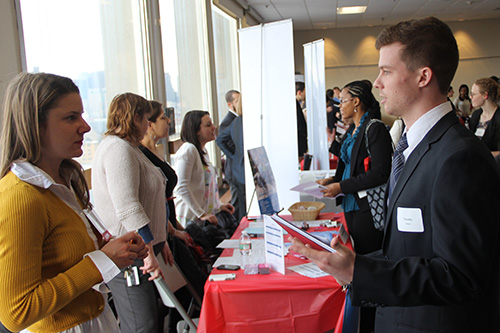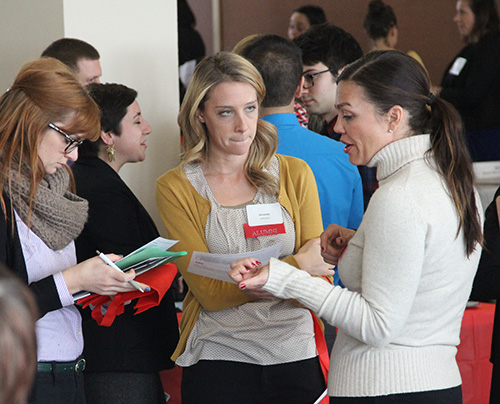Career Services Expands its Mission.
Over the past three years, the BUSPH Office of Career Services has had a quiet but effective transformation from a small, energetic career-counseling office into a full-featured facility offering an array of career assistance.
The new office, located on the first floor of the Talbot Building’s East Wing, is one of the most visible results of seven key goals outlined in the 2010 BUSPH Strategic Plan. To help BUSPH sustain its drive to be a top-tier school of public health, the plan called for establishing a career services center that enhances employment prospects for both students and alumni.
Fulfilling that goal has been Lisa Toby’s main focus since arriving at BUSPH in November 2010 as the school’s first Assistant Dean of Career Services, a role charged with ensuring that the School’s students begin thinking about their careers in public health long before they walk through the doors of the Talbot Building.
When you first arrived here from Simmons College, you spent time learning the ropes and getting a sense of what was working, and what areas needed to be developed or expanded upon. Can you talk a little bit about what you saw and what you wanted to change?
“When I came into the school in November of 2010, Maria McCarthy had been the only person in Career Services for about 13 years. Back then, most students who came here worked by day and went to school at night. There was not as much of a significant need for Career Services programming as there is today. So, when I arrived, we first focused on figuring out what was needed as the School had grown and the student population had changed to a larger full-time student body. Based on these changes, we developed a strategic plan.
“Once we developed that, we needed to think about how we were going to execute it. We needed infrastructure in terms of technology. We needed staff. We needed to build up our communications to students. We needed to expand employer outreach efforts. For the first one to two years that was a lot of the focus. There were lots of things that were really just on-the-ground infrastructure building. We built a public health career library, developed a weekly career newsletter, and launched a new password-protected career database with students, graduates and employers. In addition to posting jobs and enabling students to upload their resume into electronic resume books, for the first time, we could send mass or segmented messages and invitations to employers with a click of a button.”

With those initial efforts off the ground, what was the reasoning behind establishing the Career Prep program, which has become a centerpiece of the office’s efforts?
“When I first started, I did sort of a road show. I talked to lots of different stakeholders from faculty, to alums, to current students, the Practice Office, Student Senate, Registrar’s Office, Student Services, Education Office — everyone you could think of. Most of the people thought that we needed to offer students more career development adding on to the traditional services like resume and cover letter critiques. Where I had come from in the past, my business school had a required career course. I thought what better way than to try to develop that here. Maria McCarthy and I worked extensively with faculty and other colleagues to gain their input on what was needed and to test out curriculum ideas. We launched our Career Prep program in the fall of 2011. Now we are in our sixth semester offering it.
“The program is designed to teach job search strategies, and it starts off with using the Myers-Briggs [Type Indicator] and another career assessment called Strong Inventory. These help students reflect on their strengths, skills and passions in order to confirm their career interests, or for some, to gain a stronger starting point. Knowing yourself is the first step in the job search process. This is also important for our more experienced students who are thinking about a career change.
“As part of the program, we invite in alumni to talk about their career paths and to offer advice to students interested in their specific fields. Next, we move on to provide tips on researching the market, and using that information to market themselves to employers. Panels of recruiters come in to speak about what they look for when they’re evaluating candidates. The program continues with modules on networking, LinkedIn, interviewing and negotiation. Interviewing, for example, has gotten more rigorous than ever, often with multiple interviews including one to one, group, case and presentations. Our students are excellent, and we want to give them techniques to be stand-out candidates to employers during this process.”

You mentioned Career Prep, but what other changes has the Career Services Office needed to make to adapt to the changing work landscape itself?
“The field of public health has become incredibly diverse. MPH candidates can fit into so many different sectors. It goes beyond looking for jobs in settings like the Department of Public Health or the CDC. Many grads also work in academia, hospitals, NGO’s and nonprofits. Many are interested in going into consulting or the pharmaceutical industry. They may go into an insurance company. They might go into an analytics firm or a health IT company. It has gotten so broad. And, within each of these sectors there are multiple kinds of roles that MPH candidates can play.
“On one hand, it is very exciting because they have so many opportunities to look at. On the other hand, it can be overwhelming. Students should know about these different options, and then determine what might be a fit. We want to make that process easier. We mostly do this through talking with them individually about what we are seeing in the marketplace, and brainstorming what might appeal to them personally. It often starts with these conversations in addition to using our career library which is an excellent tool because it’s broken down by concentration. An EPI concentrator will explore very different fields versus an HPM concentrator. We have to take that kind of tailored approach because of this new diversified landscape.
“We also encourage students to do informational interviews with alumni in the field. To talk to their faculty advisor, and to get to know students in their classes to learn what they do. We tell them to attend our Career Fair, employer info sessions and other networking events so they can learn more about specific employers, and what they are looking for when hiring MPH grads.”

How early in the process are you starting that conversation with students? When are you seeing people come into the office?
“Sometimes it starts with prospective students calling us before they even apply to the program. For example, I just got a call from a prospective student who was thinking about health policy and management as a concentration. She was particularly interested in hospital administration, and asked me about the kinds of jobs that are out there for MPH grads. She wasn’t exactly sure where she wanted to target within hospital administration, so she wanted to get a better understanding of her career options.
“After students apply to the program and have been accepted, they come to Accepted Students’ Day and hear from us in Career Services. Our most important messages are start early, and leverage your time here. It goes by very fast. If they are here full-time, that means they can be in and out in three semesters. They need to think early about their career because it affects what electives they take and where they do their practicum. They want to be able to fill any gaps in their background so that they are as marketable as possible for the position they want post-graduation.
“We also talk a lot about what services we offer them. We talk about our work with employers, and that we facilitate as many networking opportunities as possible because we know that networking leads to jobs. And, we try to make matches wherever we can. We also hope that students will be in practicums that will lead into jobs. That continuum of practicum-to-job is a great strategy for students. The Practice Office is a critical partner to Career Services. We share employer relationships with them and vise-versa.”
How does that emphasis on partnerships and networking extend into the interactions that the Office has with students? During an earlier conversation, you mentioned that the approach here is much more relationship-driven as opposed to transaction-driven.
“Honestly, I would say the whole school is very relationship-driven. This is a real community. I think it is apropos for public health and it carries over to Career Services. When we work with students, we feel like we’re in it together. When they get a good job, we are celebrating with them. We also try to stay in touch with them when they leave us. Alumni receive career services for the rest of their life. Grads might come back to us a year later because now, in their new position, they are hiring. They might come back to us two or three years later because they are looking for a job again. It is very much about an ongoing relationship. We believe that is truly a differentiator for us, and we’re proud of that.”
You mentioned infrastructure and staffing earlier, but what are some of the other nuts-and-bolts steps that the office is taking to be able to extend additional services?
“Now we have the resources to do that more than ever. As of March 2014, we will have six people in our office. They each bring unique strengths and a true passion for helping students. With this full team in place, we are now able to take more of a concentration-based approach, with people in our office advising specific populations of students based on their areas of expertise. They will also expand our employer partnerships using this targeted approach. The more depth we have in a concentration, the better our advising and employer relations can continue to be.”